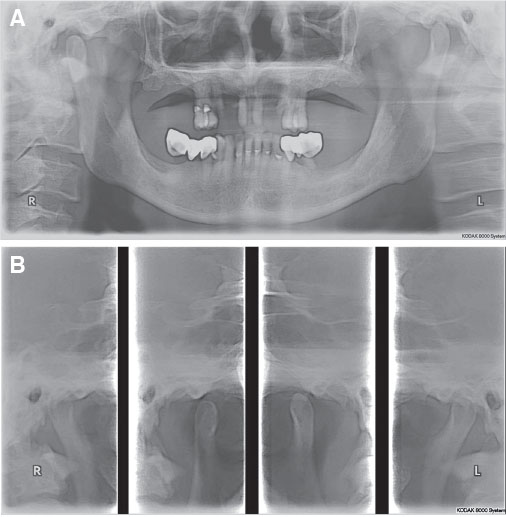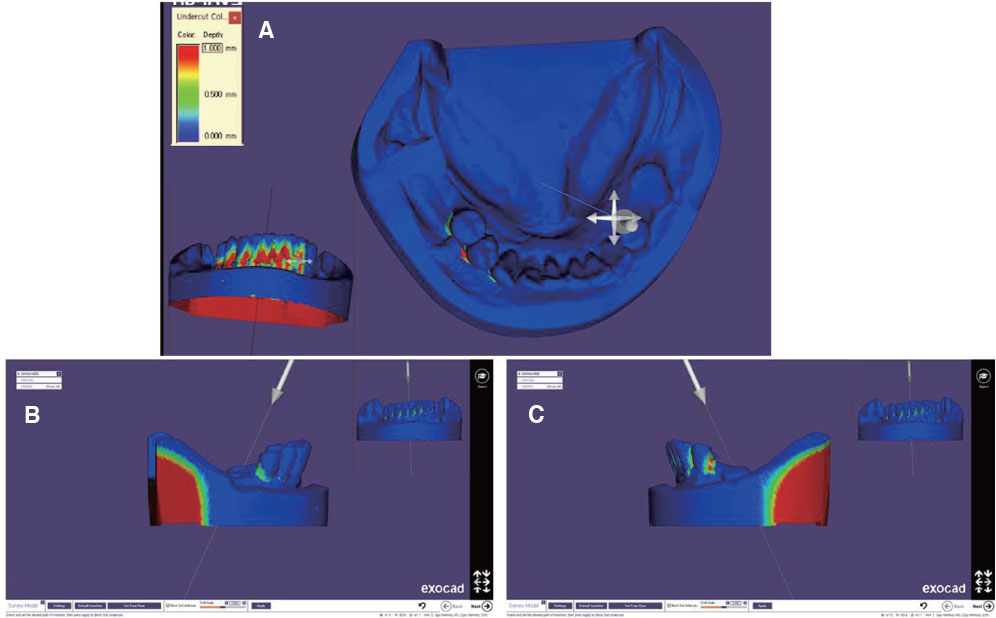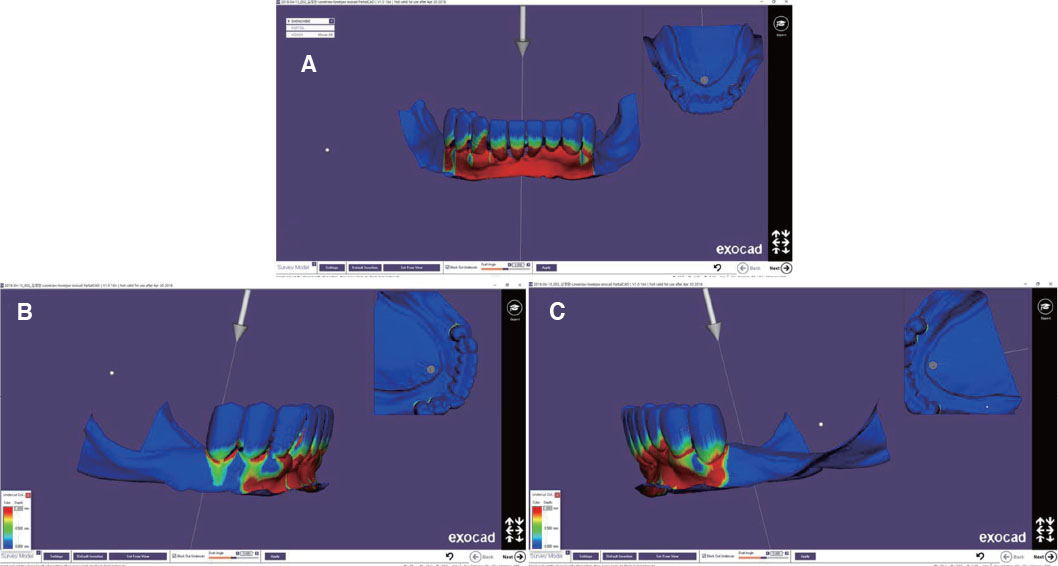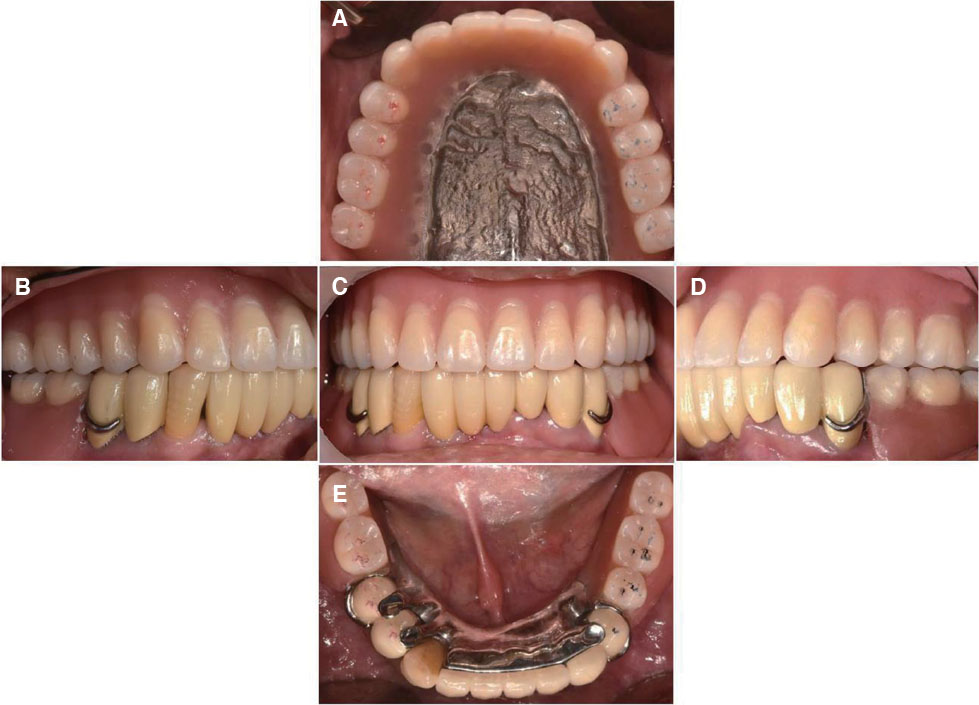J Korean Acad Prosthodont.
2018 Jul;56(3):250-257. 10.4047/jkap.2018.56.3.250.
A case of removable dentures using digital method
- Affiliations
-
- 1Department of Biomaterials & Prosthodontics, Kyung Hee University Dental Hospital at Gangdong, Seoul, Republic of Korea. hswhsh@khu.ac.kr
- KMID: 2416818
- DOI: http://doi.org/10.4047/jkap.2018.56.3.250
Abstract
- Generally dentures are manufactured by conventional method, however the frequency of fabricating denture using digital method is increasing due to the recent development of digital technology in dentistry. The digital method of manufacturing denture is classified into two systems; 3D scan of the impression to arrange the artificial teeth on the CAD (Computer-aided design) and 3D printing to produce the resin-based complete denture, or 3D scan of the model to design of the framework using CAD, resin pattern formation by 3D printing and casting of metal framework of complete denture or removable partial denture. In this case report, electronic surveying and design the metal framework of the dentures were performed using CAD program, and plastic resin patterns fabricated by 3D printing were casted for upper full denture and lower removable partial denture. During follow-up periods, dentures using digital method have provided satisfactory results esthetically and functionally.
MeSH Terms
Figure
Reference
-
1. Maeda Y, Minoura M, Tsutsumi S, Okada M, Nokubi T. A CAD/CAM system for removable denture. Part I: Fabrication of complete dentures. Int J Prosthodont. 1994; 7:17–21.2. Goodacre CJ, Garbacea A, Naylor WP, Daher T, Marchack CB, Lowry J. CAD/CAM fabricated complete dentures: concepts and clinical methods of obtaining required morphological data. J Prosthet Dent. 2012; 107:34–46.
Article3. Abduo J, Lyons K, Bennamoun M. Trends in computer-aided manufacturing in prosthodontics: a review of the available streams. Int J Dent. 2014; 2014:783948.
Article4. Stansbury JW, Idacavage MJ. 3D printing with polymers: Challenges among expanding options and opportunities. Dent Mater. 2016; 32:54–64.
Article5. Eggbeer D, Bibb R, Williams R. The computer-aided design and rapid prototyping fabrication of removable partial denture frameworks. Proc Inst Mech Eng H. 2005; 219:195–202.
Article6. Wu J, Wang X, Zhao X, Zhang C, Gao B. A study on the fabrication method of removable partial denture framework by computer aided design and rapid prototyping. Rapid Prototyp J. 2012; 18:318–323.
Article7. Lo Russo L, Salamini A. Removable complete digital dentures: A workflow that integrates open technologies. J Prosthet Dent. 2018; 119:727–732.
Article8. Miyazaki T, Hotta Y, Kunii J, Kuriyama S, Tamaki Y. A review of dental CAD/CAM: current status and future perspectives from 20 years of experience. Dent Mater J. 2009; 28:44–56.
Article9. Kattadiyil MT, Mursic Z, AlRumaih H, Goodacre CJ. Intraoral scanning of hard and soft tissues for partial removable dental prosthesis fabrication. J Prosthet Dent. 2014; 112:444–448.
Article10. Hong YS, Park EJ, Kim SK, Koak JY, Heo SJ, Park JM. Surveyed restoration and RPD framework design utilizing electronic surveying. J Korean Acad Prosthodont. 2011; 49:354–361.
Article11. Park SA, Koak JY, Heo SJ, Kim SK, Park JM. RPD framework fabrication using computer-aided design (CAD) and rapid prototyping. J Korean Acad Prosthodont. 2017; 55:94–99.
Article12. Kanazawa M, Iwaki M, Minakuchi S, Nomura N. Fabrication of titanium alloy frameworks for complete dentures by selective laser melting. J Prosthet Dent. 2014; 112:1441–1447.
Article
- Full Text Links
- Actions
-
Cited
- CITED
-
- Close
- Share
- Similar articles
-
- Comparison of digitalized fabrication method for interim removable partial denture: case reports
- Digital interim immediate denture fabrication and implant-supported removable partial denture fabrication after multiple teeth extraction in patient with chronic periodontitis: a case report
- Implant-assisted removable partial denture using digital guide surgery in partially edentulous mandible: A case report
- Fabrication of removable partial denture on scleroderma patient using 3-dimensional intraoral scanner
- Surveyed restoration and RPD framework design utilizing electronic surveying










